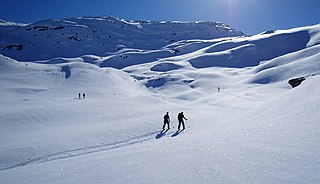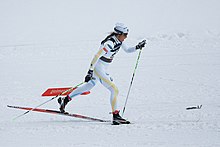
Cross-country skiing is a form of skiing whereby skiers traverse snow-covered terrain without use of ski lifts or other assistance. Cross-country skiing is widely practiced as a sport and recreational activity; however, some still use it as a means of travel. Variants of cross-country skiing are adapted to a range of terrain which spans unimproved, sometimes mountainous terrain to groomed courses that are specifically designed for the sport.

Slalom is an alpine skiing and alpine snowboarding discipline, involving skiing between poles or gates. These are spaced more closely than those in giant slalom, super giant slalom and downhill, necessitating quicker and shorter turns. Internationally, the sport is contested at the FIS Alpine World Ski Championships, and at the Olympic Winter Games.

Snowboards are boards where the user places both feet, usually secured, to the same board. The board itself is wider than most skis, with the ability to glide on snow. Snowboards widths are between 6 and 12 inches or 15 to 30 centimeters. Snowboards are differentiated from monoskis by the stance of the user. In monoskiing, the user stands with feet inline with direction of travel, whereas in snowboarding, users stand with feet transverse to the longitude of the board. Users of such equipment may be referred to as snowboarders. Commercial snowboards generally require extra equipment, such as bindings and special boots which help secure both feet of a snowboarder, who generally ride in an upright position. These types of boards are commonly used by people at ski hills, mountains, backcountry, or resorts for leisure, entertainment, and competitive purposes in the activity called snowboarding.

Skiing is the use of skis to glide on snow for basic transport, a recreational activity, or a competitive winter sport. Many types of competitive skiing events are recognized by the International Olympic Committee (IOC), and the International Ski and Snowboard Federation (FIS).
Skis are runners, attached to the user's feet, designed to glide over snow. Typically employed in pairs, skis are attached to ski boots with ski bindings, with either a free, lockable, or partially secured heel. For climbing slopes, ski skins can be affixed to the base of each ski to prevent them from sliding backwards. Originally used as a means of travel over snow, skis have become specialized for recreational and competitive alpine and cross-country skiing.

Skiing, or traveling over snow on skis, has a history of at least eight millennia. The earliest archaeological examples of skis were found in Karelia and date to 6000 BCE. Although skiing's origins were purely utilitarian, the modern sport evolved from beginnings in Scandinavia, starting in the mid-1800s skiing became a popular recreational activity and sport, becoming practiced in snow-covered regions worldwide, and providing a market for the development of ski resorts and their related communities.

Downhill is a form of alpine skiing competition. Whereas the other alpine skiing events emphasize turning and technique, downhill emphasizes "the six components of technique, courage, speed, risk, physical condition and judgement", according to the FIS "International Ski Competition Rules (ICR)". Speeds of up to 130 km/h (81 mph) are common in international competition. Athletes must have an aerodynamically efficient tuck position to minimize drag and increase speed.

Nordic walking is a Finnish-origin total-body version of walking that can be done both by non-athletes as a health-promoting physical activity and by athletes as a sport. The activity is performed with specially designed walking poles similar to ski poles.
Trekking poles are a common hiking accessory that function to assist walkers with their rhythm, to provide stability, and reduce strain on joints on rough terrain.

Roller skiing is an off-snow equivalent to cross-country skiing. Roller skis have wheels on their ends and are used on a hard surface to emulate cross-country skiing. The skiing techniques used are very similar to techniques used in cross-country skiing on snow.
LW12 is a para-alpine and para-Nordic sit skiing sport class defined by the International Paralympic Committee (IPC). An LW12 skier needs to meet a minimum of one of several conditions including a single below knee but above ankle amputation, monoplegia that exhibits similar to below knee amputation, legs of different length where there is at least a 7 centimetres difference, combined muscle strength in the lower extremities less than 71. For international competitions, classification is done through IPC Alpine Skiing or IPC Nordic Skiing. For sub-international competitions, classification is done by a national federation such as Alpine Canada. For para-alpine, this class is subdivided into two subclasses.: LW12.1 and LW12.2. A new sit-skier competitor with only national classification will compete as LW12.2 in international competitions until they have been internationally classified.

LW10 is a para-alpine and para-Nordic sit-skiing classification for skiers who cannot sit up without support. For international skiing competitions, classification is conducted by IPC Alpine Skiing and IPC Nordic Skiing, while national federations such as Alpine Canada handle classification for domestic competitions.

LW2 is a para-alpine and para-Nordic standing ski sport class defined by the International Paralympic Committee (IPC). Competitors in this class have severe disability in a lower limb, which may be a result of an amputation, or arthrodesis in the leg and hip. Depending on the type of skiing, the international classification process for LW2 skiers is handled by the IPC Alpine Skiing Technical Committee and IPC Nordic Skiing Technical Committee. National sport federations handle classification on the lower levels.
LW3 is a para-alpine and para-Nordic standing skiing sport class defined by the International Paralympic Committee (IPC) for skiers with a disability affecting both legs, with double below knee amputation or a combined strength total for both legs of 60, with 80 as the baseline for people without disabilities. For international skiing competitions, classification is done through IPC Alpine Skiing or IPC Nordic Skiing. The classification has two subclasses for para-alpine skiing: LW3.1 which is for people with double below the knee amputations or similar disabilities, and LW3.2 which is for people with cerebral palsy that involves moderate athetoid, moderate ataxic impairment or slight diplegic involvement.
LW4 is a para-alpine and para-Nordic standing skiing sport class defined by the International Paralympic Committee (IPC) for skiers who may have a disability in one lower extremity, which may be a result of a leg amputation below the knee, knee arthrodesis or a hip arthrodesis. For international skiing competitions, classification is done through IPC Alpine Skiing or IPC Nordic Skiing. A national federation such as Alpine Canada handles classification for domestic competitions.
LW5/7 is a standing para-alpine and para-Nordic skiing classification for skiers with upper extremity issues in both limbs that may include double amputation of both arms and hands or dysmelia of the upper limbs. The class has three subclasses defined by the location of the disability on the upper extremities. International classification is done by IPC Alpine Skiing and IPC Nordic Skiing. On the national level, classification is handled by national sports federation such as Cross-Country Canada.

LW6/8 is a para-alpine and para-Nordic standing skiing sport class, a classification defined by the International Paralympic Committee (IPC) for people with an upper extremity issue who have paralysis, motor paresis affecting one arm, a single upper arm amputation or CP8 classified cerebral palsy. LW6/8 skiers use two skis and one pole in both para-alpine and para-Nordic skiing.
LW9 is a para-alpine and para-Nordic standing skiing sport class, a classification defined by the International Paralympic Committee (IPC) for people with upper and lower limb function problems, and includes cerebral palsy skiers classified CP5, CP6 and CP7, along with people with hemiplegia or amputations. For international skiing competitions, classification is done through IPC Alpine Skiing or IPC Nordic Skiing. A national federation such as Alpine Canada handles classification for domestic competitions. This classification is separated into two subclasses including LW9.1 and LW9.2.

Competitive cross-country skiing encompasses a variety of race formats and course lengths. Rules of cross-country skiing are sanctioned by the International Ski Federation and by various national organizations. International competitions include the FIS Nordic World Ski Championships, the FIS Cross-Country World Cup, and at the Winter Olympic Games. Such races occur over homologated, groomed courses designed to support classic (in-track) and freestyle events, where the skiers may employ skate skiing. It also encompasses cross-country ski marathon events, sanctioned by the Worldloppet Ski Federation, and cross-country ski orienteering events, sanctioned by the International Orienteering Federation. Related forms of competition are biathlon, where competitors race on cross-country skis and stop to shoot at targets with rifles, and paralympic cross-country skiing that allows athletes with disabilities to compete at cross-country skiing with adaptive equipment.
This glossary of skiing and snowboarding terms is a list of definitions of terms and jargon used in skiing, snowboarding, and related winter sports.















